Establishment and Application of a New Parameter Model for Quantitative Characterization of the Heterogeneity of Thick, Coarse-Grained Clastic Reservoirs: A Case Study of the Badaowan Formation in the Western Slope of the Mahu Depression, Junggar Basin, China
Abstract
:1. Introduction
2. Limitations of Conventional Heterogeneous Characterization Parameters
3. Materials and Methods
3.1. Materials
3.2. Methods
3.2.1. Parameter Establishment Process
3.2.2. Parameter Proposal
4. Results
4.1. Petrological Characteristics
4.2. Physical Characteristics
4.3. Pore Structure Characteristics
4.4. Reservoir Interpretation Parameter Model
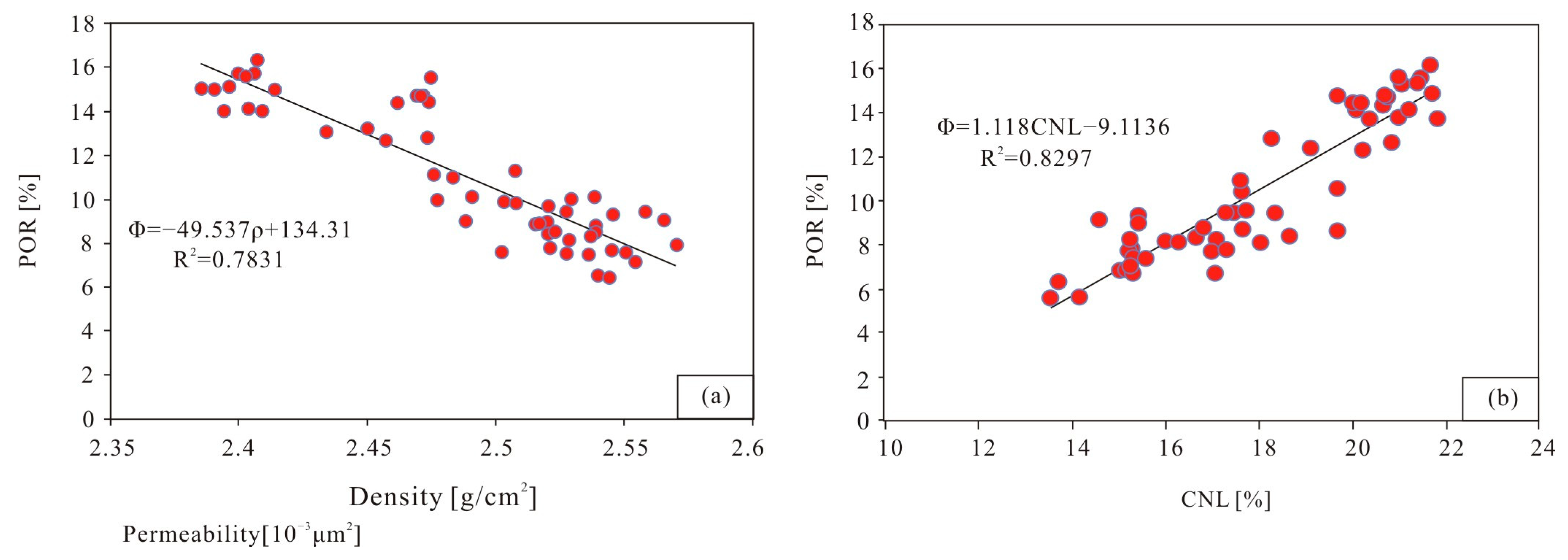
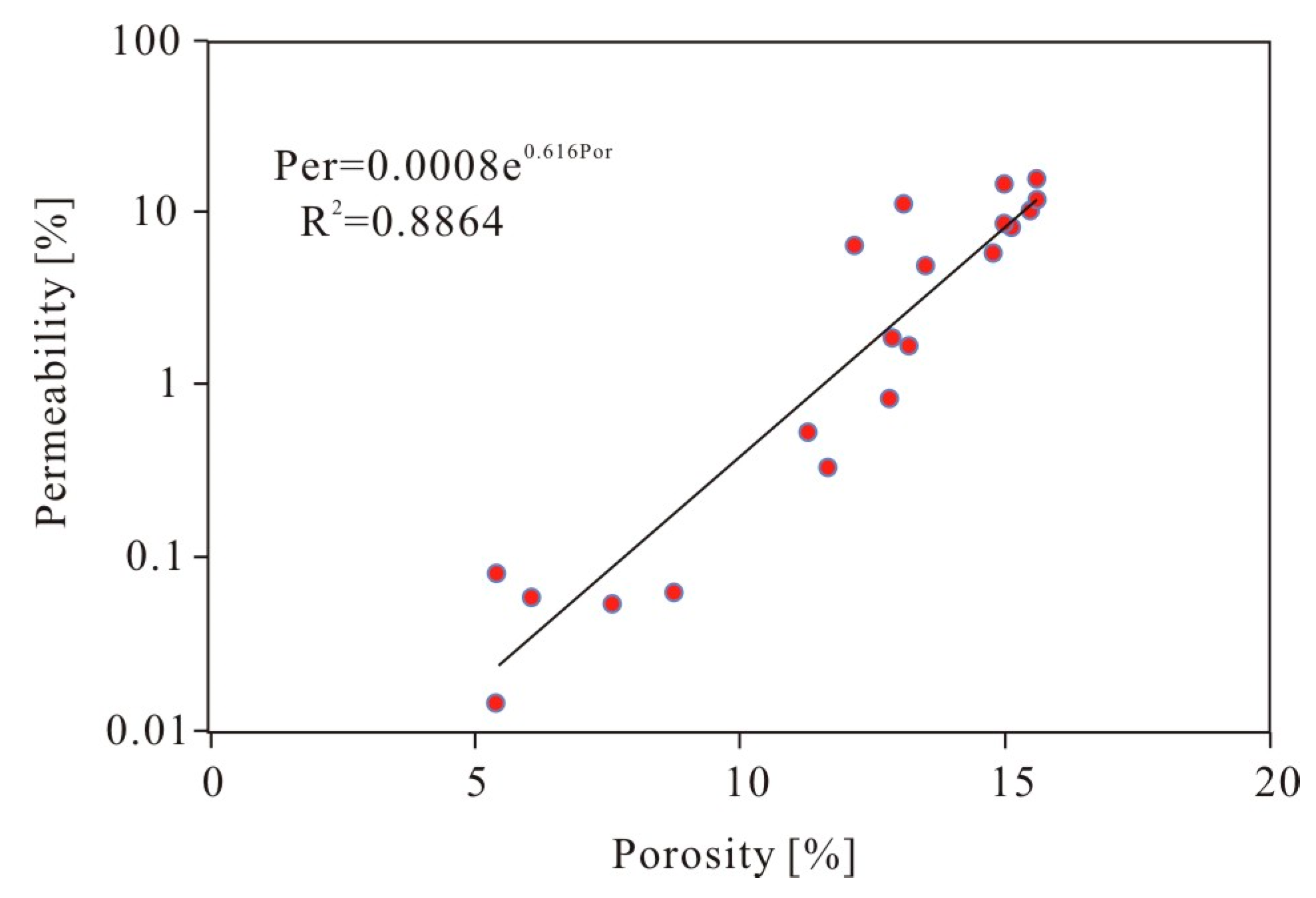
4.5. Reservoir Heterogeneity Evaluation
5. Discussion
5.1. Causes of Strong Heterogeneity Reservoir Control
5.2. Geological Significance of the Fluctuation Coefficient
6. Conclusions
Author Contributions
Funding
Data Availability Statement
Conflicts of Interest
References
- Yang, S.C. A new method for quantitative study of reservoir heterogeneity. J. Univ. Pet. 2000, 24, 53–56. [Google Scholar]
- Yan, K.; Yang, S.C.; Ren, H.Q. Quantitative characterization of macroscopic heterogeneity in layers. Acta Pet. Sin. 2008, 29, 870–874. [Google Scholar]
- Liu, C.; Ma, K.Q.; Li, H.Y.; Li, Y.L.; Zhang, W. Improvement and application of reservoir heterogeneity characterization method based on Lorentz curve statutory scale. COOG 2012, 24, 36–38, 43. [Google Scholar]
- Song, T.; Huang, F.X.; Wang, S.Y.; Yang, F.; Lu, W.N.; Liu, C.; Jia, P.; Fan, J.J. Characteristics and exploration potential of Jurassic reservoirs in Mahu Sag, Junggar Basin. China Pet Explor. 2008, 20, 37–42. [Google Scholar] [CrossRef]
- Wang, C.Y.; Zheng, R.C.; Wang, J.G.; Cao, S.F.; Xiao, M.G. Sedimentary characteristics and evolution of the Lower Jurassic Badaowan Formation in the Eighth District, northwest margin of Junggar Basin. Geol. Rev. 2008, 20, 37–42. [Google Scholar]
- Chen, H.Q.; Yu, J.; Du, Y.J. Advances in reservoir heterogeneity research methods. Geol J. Univ. 2017, 23, 104–116. [Google Scholar] [CrossRef]
- He, Y.; Yin, J.; Wu, N.S. A geostatistical method for describing reservoir heterogeneity. J. Southwest Pet. Univ. 2001, 3, 13–15. [Google Scholar]
- Foroshani, J.S.; Mehrabi, H.; Rahimpour-Bonab, H. Reservoir heterogeneity of Upper Cretaceous Sarvak Formation in the Dezful Embayment, SW Iran: Implications of flow unit distribution, electrofacies analysis and geological-based reservoir zonation. J. Afr. Earth Sci. 2023, 200, 104882. [Google Scholar] [CrossRef]
- Al-Hasani, A.; Hakimi, M.H.; Saaid, I.M.; Salim, A.M.; Mahat, S.Q.A.; Ahmed, A.A.; Umar, A.A.B. Reservoir characteristics of the Kuhlan sandstones from Habban oilfield in the Sabatayn Basin, Yemen and their relevance to reservoir rock quality and petroleum accumulation. J. Afr. Earth Sci. 2018, 145, 131–147. [Google Scholar] [CrossRef]
- Kadkhodaie-Ilkhchia, R.; Kadkhodaiea, A.; Rezaeeb, R.; Mehdipour, V. Unraveling the reservoir heterogeneity of the tight gas sandstones using the porosity conditioned facies modeling in the Whicher Range field, Perth Basin, Western Australia. J. Pet. Sci. Eng. 2019, 176, 97–115. [Google Scholar] [CrossRef]
- Mahgoub, M.I.; Abdullatif, O.M. Facies, petrography, reservoir heterogeneity and quality of the late Carboniferous-Permian Juwayl Member, Wajid Sandstone, SW Saudi Arabia. Mar. Pet. Geol. 2020, 120, 104521. [Google Scholar] [CrossRef]
- Huang, S.Y.; Lin, C.M.; Zhang, X.; Zhang, N. Controls of diagenesis on the quality of shallowly buried terrestrial coarse-grained clastic reservoirs: A case study of the Eocene Shahejie Formation in the Damintun Sag, Bohai Bay Basin, Eastern China. J. Asian Earth Sci. 2021, 221, 104950. [Google Scholar] [CrossRef]
- Tian, J.X.; Ji, B.Q.; Zeng, X.; Wang, Y.T.; Li, Y.L.; Sun, G.Q. Development characteristics and main control factors of deep clastic reservoirs of the Xiaganchaigou Formation in the northern marin of the Qaidam Basin, China. J. Nat. Gas Geosci. 2022, 7, 225–235. [Google Scholar] [CrossRef]
- Li, M.; Wu, G.H.; Xia, B.; Huang, T.Z.; Ni, B.; Pang, S.Y.; Long, X.L. Controls on hydrocarbon accumulation in clastic reservoirs of the Tarim Craton, NW China. Mar. Pet. Geol. 2019, 104, 423–437. [Google Scholar] [CrossRef]
- Zhao, D.D.; Hou, J.G.; Sarma, H.; Guo, W.J.; Liu, Y.M.; Xie, P.F.; Dou, L.X.; Chen, R.X.; Zhang, Z.Y. Pore throat heterogeneity of different lithofacies and diagenetic effects in gravelly braided river deposits: Implications for understanding the formation process of high-quality reservoirs. J. Pet. Geoenergy Sci. Eng. 2023, 221, 111309. [Google Scholar] [CrossRef]
- Liu, M.J.; Xiong, C. Diagenesis and reservoir quality of deep-lacustrine sandy-debris-flow tight sandstones in Upper Triassic Yanchang Formation, Ordos Basin, China: Implications for reservoir heterogeneity and hydrocarbon accumulation. J. Pet. Sci. Eng. 2021, 202, 108548. [Google Scholar] [CrossRef]
- Wan, Q.; Fan, A.-P.; Yang, R.-C.; Lenhardt, N. Diagenetic mineralogy and its effect on the reservoir properties of the sandstones of the Permian of S120 block (Sulige gas field), Ordos Basin, NW China. J. Palaeogeogr. 2022, 11, 360–386. [Google Scholar] [CrossRef]
- Shang, X.F.; Hou, J.G.; Dong, Y. Genesis of reservoir heterogeneity and its impacts on petroleum exploitation in beach-bar sandstone reservoirs: A case study from the Bohai Bay Basin, China. Energy Geosci. 2022, 3, 35–48. [Google Scholar] [CrossRef]
- Fawad, N.; Liu, T.X.; Fan, D.D.; Ahmed, Q.A.; Kamran, M.; Ayub, G. Sequence stratigraphic divisions and correlation of the middle sub-member of Eocene Shahejie Formation in the Bonan Sag of Bohai Bay Basin (China): Implication for facies and reservoir heterogeneities. Geoenergy Sci. Eng. 2023, 225, 211622. [Google Scholar] [CrossRef]
- Zhang, Q.; Wu, X.-S.; Radwan, A.E.; Wang, B.-H.; Wang, K.; Tian, H.-Y.; Yin, S. Diagenesis of continental tight sandstone and its control on reservoir quality: A case study of the Quan 3 member of the cretaceous Quantou Formation, Fuxin uplift, Songliao Basin. Mar. Pet. Geol. 2022, 145, 105883. [Google Scholar] [CrossRef]
- Li, Y.; Fan, A.P.; Yang, R.C.; Sun, Y.P.; Lenhardt, N. Sedimentary facies control on sandstone reservoir properties: A case study from the permian Shanxi Formation in the southern Ordos basin, central China. Mar. Pet. Geol. 2021, 129, 105083. [Google Scholar] [CrossRef]
- Zhou, J.S.; Qiao, X.Y.; Wang, R.G.; Yin, X.; Cao, J.; Cao, B.F.; Lei, Y.H.; Tian, K.; Zhao, Z.D.; Zhugeng, B. Effective reservoir development model of tight sandstone gas in Shanxi Formation of Yan’an Gas Field, Ordos Basin, China. J. Nat. Gas Geosci. 2022, 7, 73–84. [Google Scholar] [CrossRef]
- Dongling, X.; Yue, W.; Min, Z.; Dongdong, X.; Wen, P. Quality characterization of tight sandstone reservoirs in the Yanchang Formation of the Honghe oilfield, Ordos Basin, central China. Energy Geosci. 2021, 3, 444–452. [Google Scholar] [CrossRef]
- Ali, A.; Zaky, K.S.; Wagreich, M.; Skupien, P.; Ahmed, M.S.; Mohamed, R.S. Factors affecting the development of deformation bands in the Nubian Sandstone, Central Eastern Desert, Egypt. J. Afr. Earth Sci. 2022, 192, 104573. [Google Scholar] [CrossRef]
- Li, M.; Guo, Y.H.; Li, Z.F.; Wang, H.C. The diagenetic controls of the reservoir heterogeneity in the tight sand gas reservoirs of the Zizhou Area in China’s east Ordos Basin: Implications for reservoir quality predictions. Mar. Pet. Geol. 2020, 112, 104088. [Google Scholar] [CrossRef]
- Burki, M.; Darwish, M. Electrofacies vs. lithofacies sandstone reservoir characterization Campanian sequence, Arshad gas/oil field, Central Sirt Basin, Libya. J. Afr. Earth Sci. 2017, 130, 319–336. [Google Scholar] [CrossRef]
- Wang, Z.N.; Luo, X.R.; Lei, Y.H.; Zhang, L.K.; Shi, H.; Lu, J.H.; Cheng, M.; Liu, N.G.; Wang, X.Z.; He, Y.H.; et al. Impact of detrital composition and diagenesis on the heterogeneity and quality of low-permeability to tight sandstone reservoirs: An example of the Upper Triassic Yanchang Formation in Southeastern Ordos Basin. J. Pet. Sci. Eng. 2020, 195, 107596. [Google Scholar] [CrossRef]
- Radwan, A.A.; Nabawy, B.S.; Shihata, M.; Leila, M. Seismic interpretation, reservoir characterization, gas origin and entrapment of the Miocene-Pliocene Mangaa C sandstone, Karewa Gas Field, North Taranaki Basin, New Zealand. Mar. Pet. Geol. 2022, 135, 105420. [Google Scholar] [CrossRef]
- Sun, P.K.; Xu, H.M.; Zhu, H.Q.; Jia, L.B.; Hu, X.N.; Fang, H.J.; Jiang, H.Q.; Xu, Z.H.; Jiang, T.W.; Jiang, X.; et al. Investigation of pore-type heterogeneity and its control on microscopic remaining oil distribution in deeply buried marine clastic reservoirs. Mar. Pet. Geol. 2021, 123, 104750. [Google Scholar] [CrossRef]
- Sun, J.; You, X.C.; Zhang, Q.; Xue, J.J.; Chang, Q.S. Development characteristics and genesis of deep tight conglomerate res-ervoirs of Mahu area in Junggar Basin, China. J. Nat Gas Geosci. 2023, 8, 201–212. [Google Scholar] [CrossRef]
- Zhao, X.; Zhang, S.; Yang, S.; Ju, X.; Chen, G.; Zhang, X.; Khan, D.; Zhang, Y.; Zhang, J. Controlling factors of carbonate cement and its influence on oil-water distribution of the Neogene Shawan Formation in the northern Chepaizi area, Junggar Basin, NW China. J. Pet. Sci. Eng. 2021, 206, 108942. [Google Scholar] [CrossRef]
- Zhao, X.; Wang, S.; Yang, J.; Zhang, B.; Li, L.; Liu, X.; Wen, W.; Zhang, Y. Evaluation method for low- to ultralow-permeability reservoirs based on pore-throat structure: A case study in the eastern Nanpu Sag, Bohai Bay Basin, China. Interpretation 2021, 9, T315–T329. [Google Scholar] [CrossRef]
- Qiao, J.C.; Zeng, J.H.; Jiang, S.; Ma, Y.; Feng, S.; Xie, H.F.; Wang, Y.N.; Hu, H.T. Role of pore structure in the percolation and storage capacities of deeply buried sandstone reservoirs: A case study of the Junggar Basin, China. Mar. Pet. Geol. 2020, 113, 104129. [Google Scholar] [CrossRef]
- Gao, C.L.; Wang, J.; Jin, J.; Liu, M.; Ren, Y.; Liu, K.; Wang, K.; Deng, Y. Heterogeneity and differential hydrocarbon accumulation model of deep reservoirs in foreland thrust belts: A case study of deep Cretaceous Qingshuihe Formation clastic reservoirs in southern Junggar Basin, NW China. Pet. Explor. Dev. 2023, 50, 360–372. [Google Scholar] [CrossRef]
- Du, S.H.; Pang, S.; Shi, Y.M. Quantitative characterization on the microscopic pore heterogeneity of tight oil sandstone reservoir by considering both the resolution and representativeness. J. Pet. Sci. Eng. 2018, 169, 388–392. [Google Scholar] [CrossRef] [Green Version]
- Peng, J.; Han, H.D.; Xia, Q.S.; Li, B. Fractal characteristic of microscopic pore structure of tight sandstone reservoirs in Kalpintag Formation in Shuntuoguole area, Tarim Basin. Pet. Res. 2020, 5, 1–17. [Google Scholar] [CrossRef]
- Qiao, J.C.; Zeng, J.H.; Cai, J.C.; Jiang, S.; An, T.; Xiao, E.Z.; Zhang, Y.C.; Feng, X.; Yang, G.Q. Pore-scale heterogeneity of tight gas sandstone: Origins and impacts. J. Nat. Gas Sci. Eng. 2021, 96, 104248. [Google Scholar] [CrossRef]
- Davies, A.; Cowliff, L.; Simmons, M.D. A method for fine-scale vertical heterogeneity quantification from well data and its application to siliciclastic reservoirs of the UKCS. Mar. Pet. Geol. 2023, 149, 106077. [Google Scholar] [CrossRef]
- Abdelkarim, A.A.; Makkawi, M.H.; Abdullatif, O.M. Insights on spatial variography and outcrop-subsurface relationship of sandstone reservoir properties: A case study from the Late Triassic Minjur Formation, central Saudi Arabia. J. Afr. Earth Sci. 2019, 153, 173–184. [Google Scholar] [CrossRef]
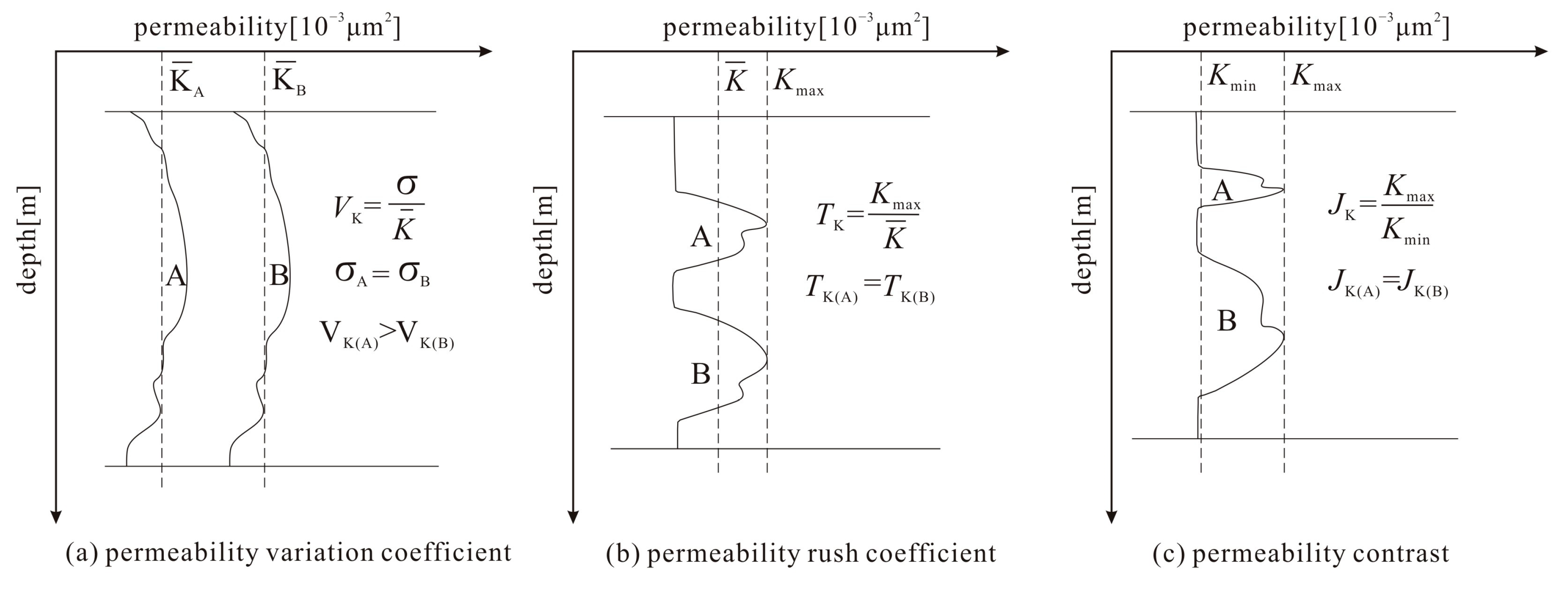


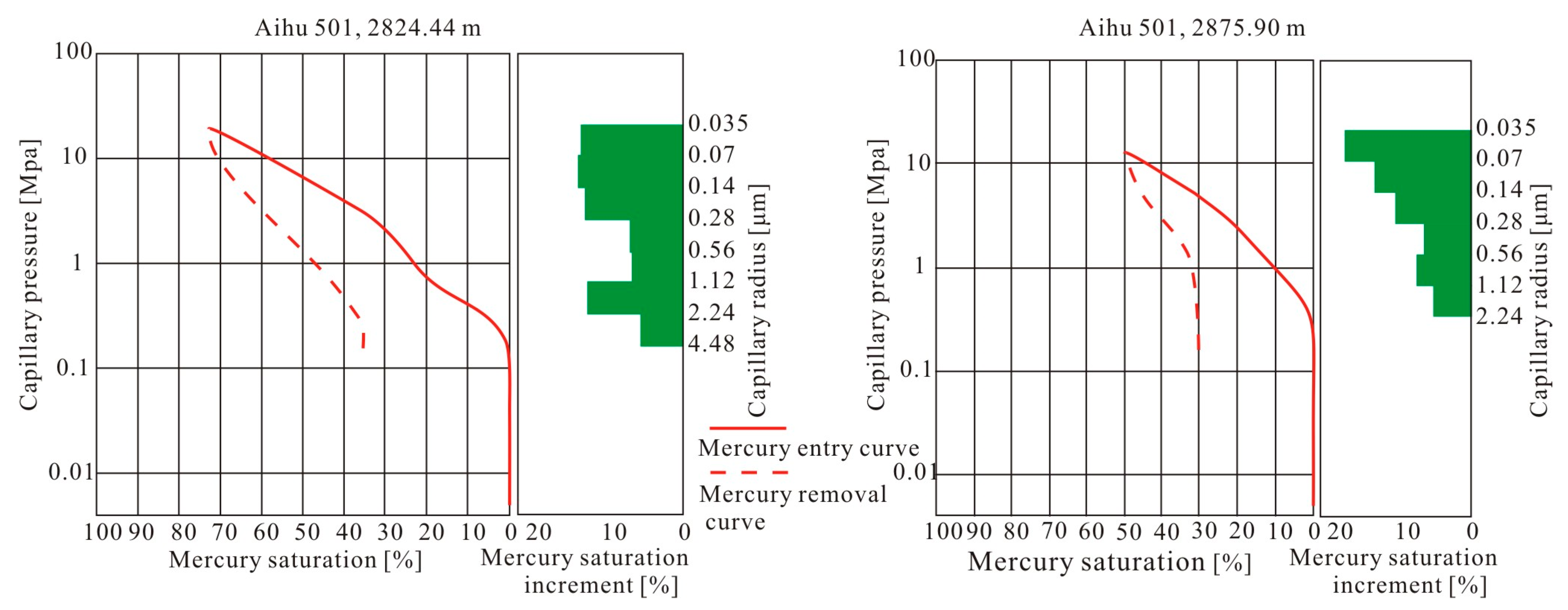
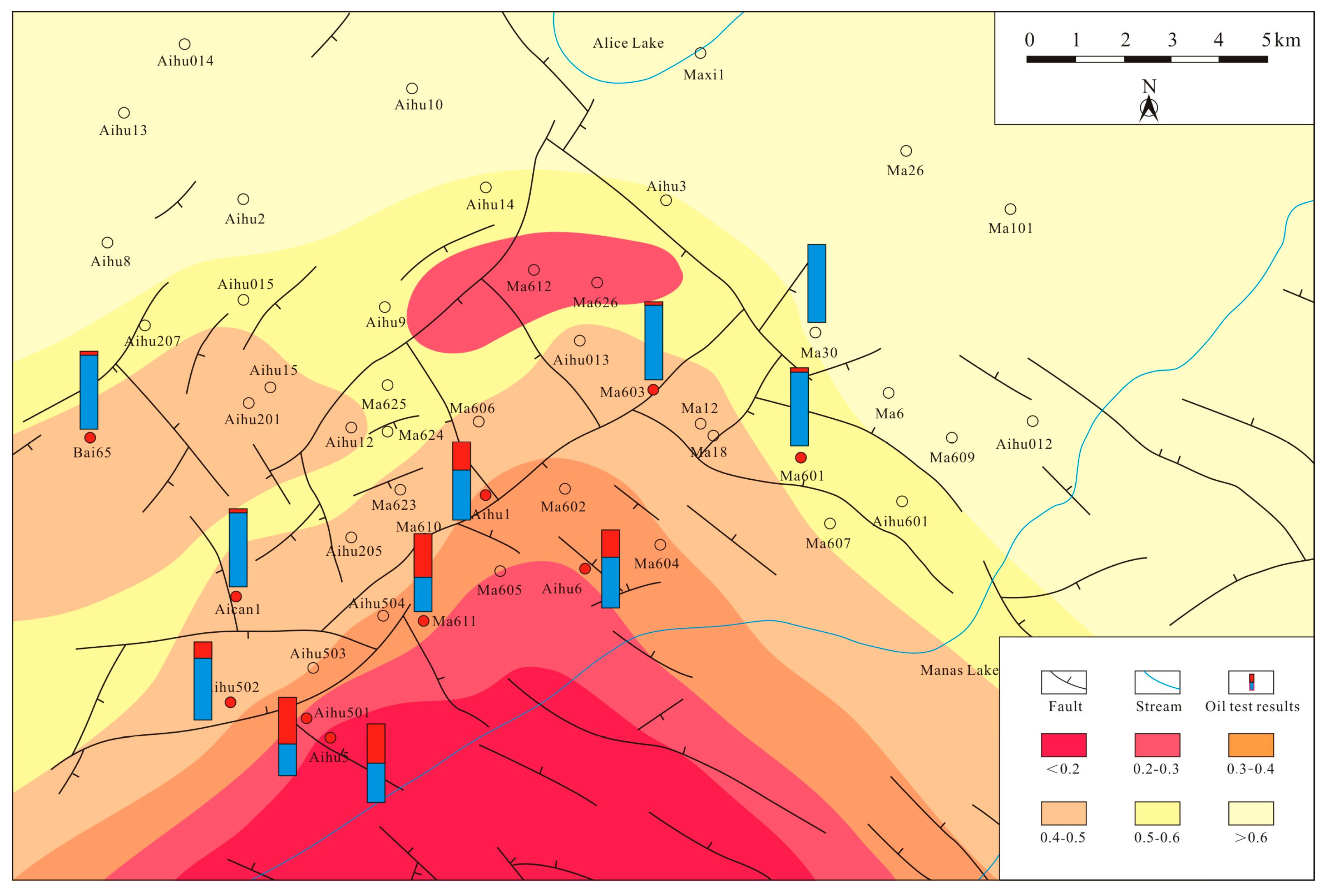
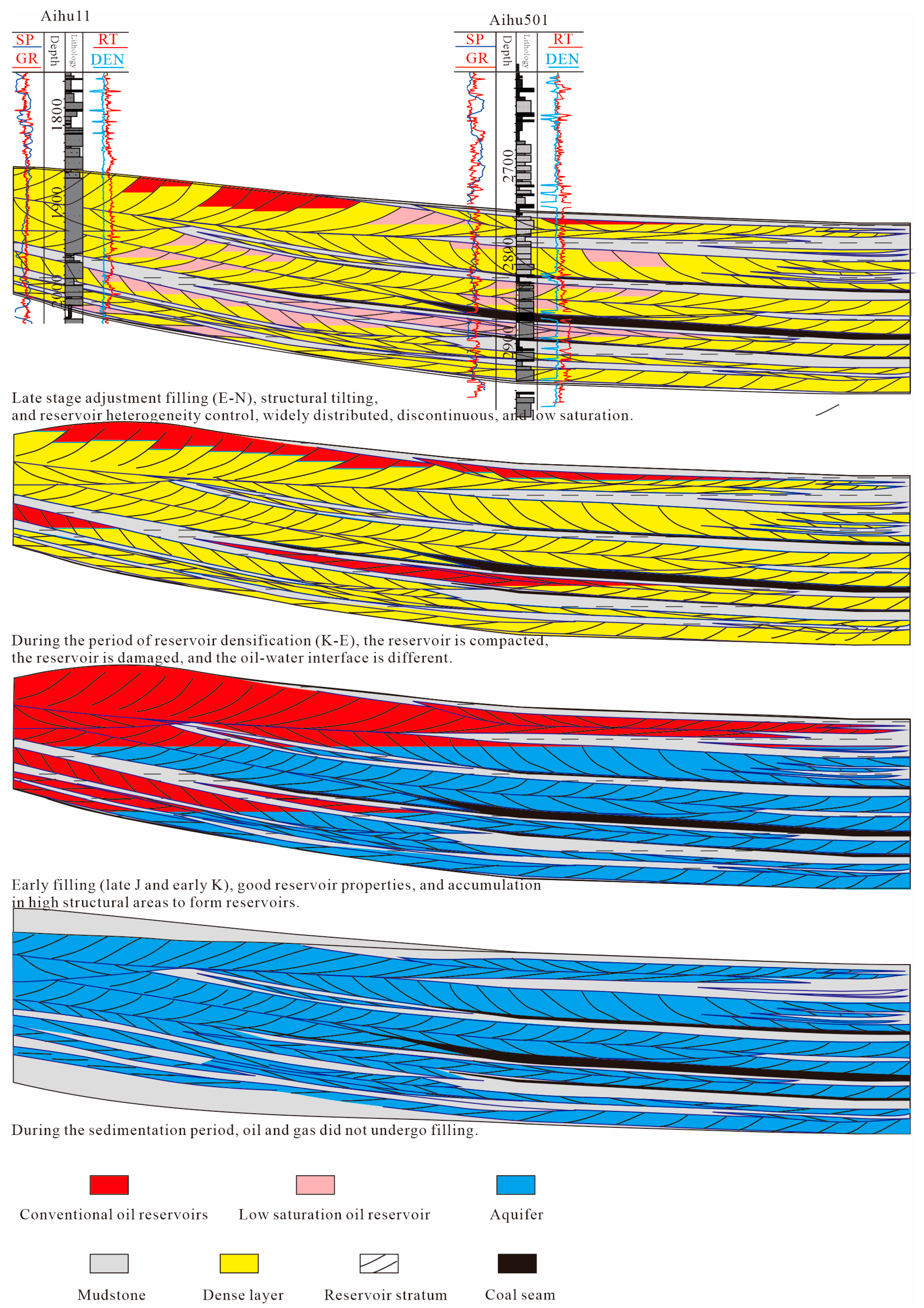
| Well | Starting Depth [m] | Stop Depth [m] | Coefficient of Fluctuation |
|---|---|---|---|
| Aican 1 | 2720.4 | 2727.5 | 0.47 |
| Ma 601 | 2800 | 2812.1 | 0.39 |
| Ma 603 | 2748.2 | 2769.7 | 0.57 |
| Ma 30 | 2764.3 | 2771.9 | 0.18 |
| Aihu 502 | 2783.7 | 2796.7 | 0.27 |
| Aihu 501 | 2824.3 | 2829.4 | 0.46 |
| Aihu 6 | 2817.2 | 2821.6 | 0.25 |
| Aihu 1 | 2768.1 | 2790.1 | 0.44 |
| Ma 611 | 2807.9 | 2821.2 | 0.36 |
| Aihu 5 | 2835.9 | 2847.1 | 0.2 |
Disclaimer/Publisher’s Note: The statements, opinions and data contained in all publications are solely those of the individual author(s) and contributor(s) and not of MDPI and/or the editor(s). MDPI and/or the editor(s) disclaim responsibility for any injury to people or property resulting from any ideas, methods, instructions or products referred to in the content. |
© 2023 by the authors. Licensee MDPI, Basel, Switzerland. This article is an open access article distributed under the terms and conditions of the Creative Commons Attribution (CC BY) license (https://creativecommons.org/licenses/by/4.0/).
Share and Cite
Zhou, B.; Zhao, X.; Ji, X.; Wu, X.; Zhao, W.; Rong, X. Establishment and Application of a New Parameter Model for Quantitative Characterization of the Heterogeneity of Thick, Coarse-Grained Clastic Reservoirs: A Case Study of the Badaowan Formation in the Western Slope of the Mahu Depression, Junggar Basin, China. Processes 2023, 11, 2423. https://doi.org/10.3390/pr11082423
Zhou B, Zhao X, Ji X, Wu X, Zhao W, Rong X. Establishment and Application of a New Parameter Model for Quantitative Characterization of the Heterogeneity of Thick, Coarse-Grained Clastic Reservoirs: A Case Study of the Badaowan Formation in the Western Slope of the Mahu Depression, Junggar Basin, China. Processes. 2023; 11(8):2423. https://doi.org/10.3390/pr11082423
Chicago/Turabian StyleZhou, Boyu, Xiaodong Zhao, Xuebing Ji, Xinyu Wu, Wenping Zhao, and Xi Rong. 2023. "Establishment and Application of a New Parameter Model for Quantitative Characterization of the Heterogeneity of Thick, Coarse-Grained Clastic Reservoirs: A Case Study of the Badaowan Formation in the Western Slope of the Mahu Depression, Junggar Basin, China" Processes 11, no. 8: 2423. https://doi.org/10.3390/pr11082423





